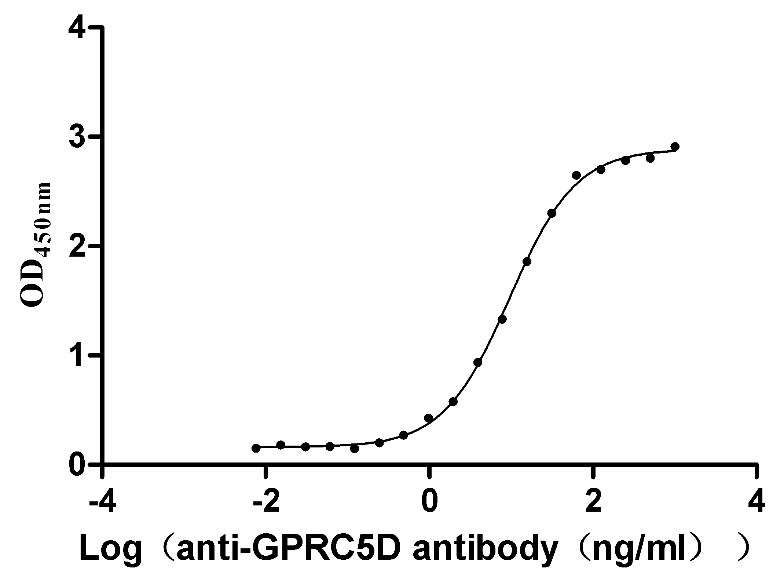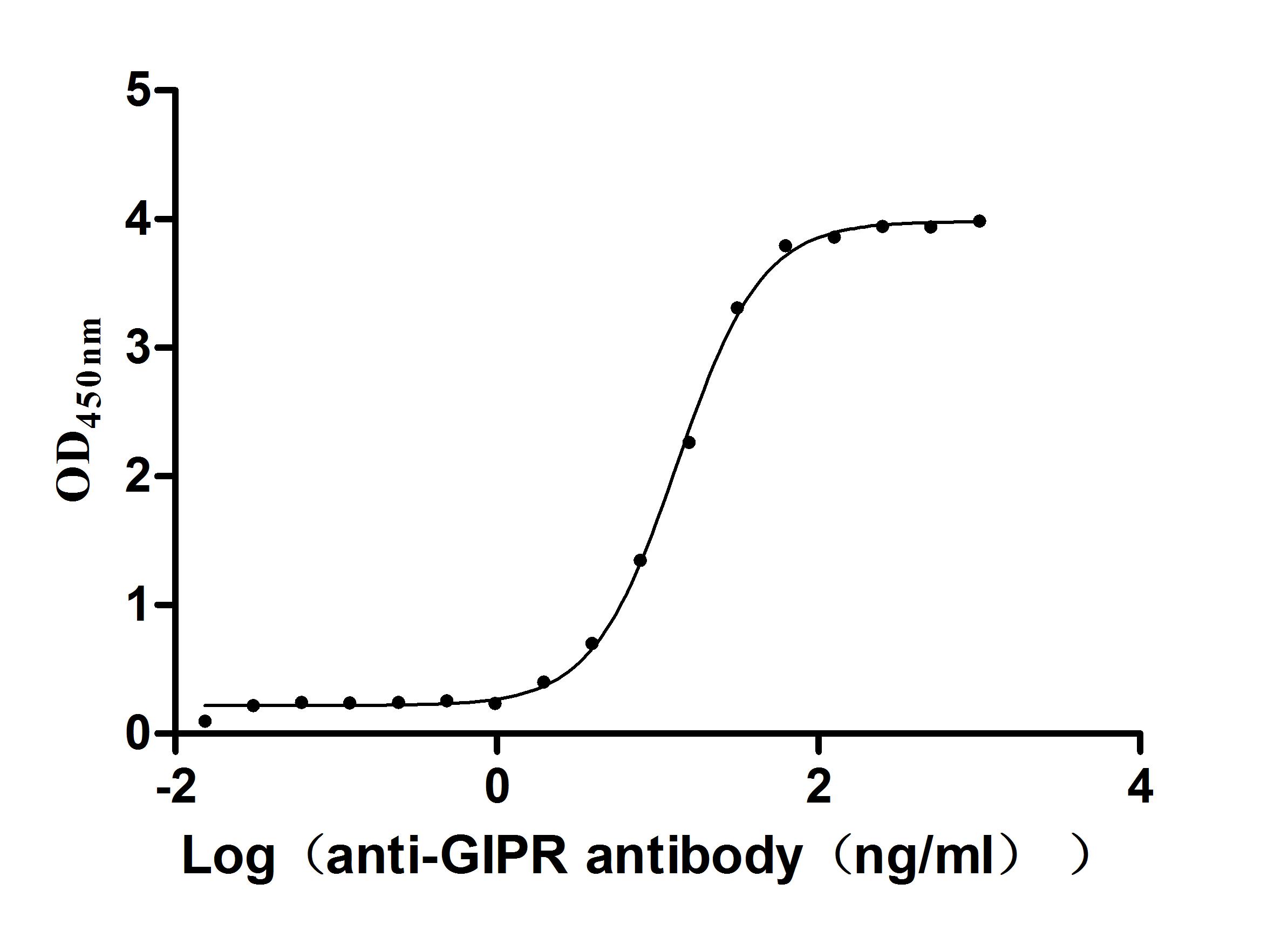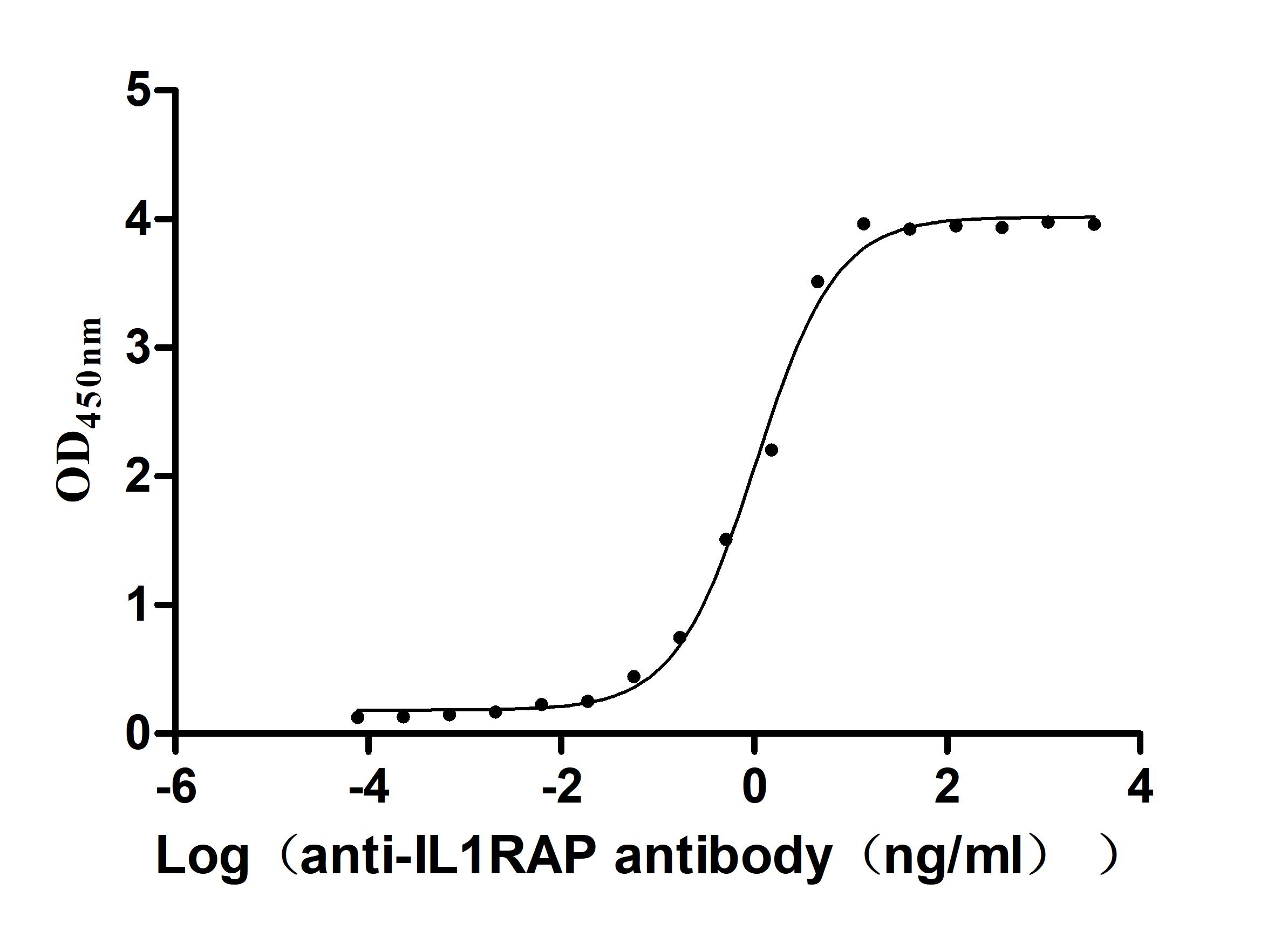Recombinant Human Solute carrier family 15 member 1 (SLC15A1), partial
-
中文名称:人SLC15A1重组蛋白
-
货号:CSB-YP021398HU
-
规格:
-
来源:Yeast
-
其他:
-
中文名称:人SLC15A1重组蛋白
-
货号:CSB-EP021398HU
-
规格:
-
来源:E.coli
-
其他:
-
中文名称:人SLC15A1重组蛋白
-
货号:CSB-EP021398HU-B
-
规格:
-
来源:E.coli
-
共轭:Avi-tag Biotinylated
E. coli biotin ligase (BirA) is highly specific in covalently attaching biotin to the 15 amino acid AviTag peptide. This recombinant protein was biotinylated in vivo by AviTag-BirA technology, which method is BriA catalyzes amide linkage between the biotin and the specific lysine of the AviTag.
-
其他:
-
中文名称:人SLC15A1重组蛋白
-
货号:CSB-BP021398HU
-
规格:
-
来源:Baculovirus
-
其他:
-
中文名称:人SLC15A1重组蛋白
-
货号:CSB-MP021398HU
-
规格:
-
来源:Mammalian cell
-
其他:
产品详情
-
纯度:>85% (SDS-PAGE)
-
基因名:SLC15A1
-
Uniprot No.:
-
别名:+peptide cotransporter; HPECT1; HPEPT1; Human peptide transporter (HPEPT1) mRNA complete cds; Intestinal H; Intestinal H(+)/peptide cotransporter; Oligopeptide transporter; Oligopeptide transporter small intestine isoform; PEPT1; Peptide transporter 1; S15A1_HUMAN; Slc15a1; small intestine isoform; Solute carrier family 15 (oligopeptide transporter) member 1; Solute carrier family 15 member 1
-
种属:Homo sapiens (Human)
-
蛋白长度:Partial
-
蛋白标签:Tag type will be determined during the manufacturing process.
The tag type will be determined during production process. If you have specified tag type, please tell us and we will develop the specified tag preferentially. -
产品提供形式:Lyophilized powder
Note: We will preferentially ship the format that we have in stock, however, if you have any special requirement for the format, please remark your requirement when placing the order, we will prepare according to your demand. -
复溶:We recommend that this vial be briefly centrifuged prior to opening to bring the contents to the bottom. Please reconstitute protein in deionized sterile water to a concentration of 0.1-1.0 mg/mL.We recommend to add 5-50% of glycerol (final concentration) and aliquot for long-term storage at -20℃/-80℃. Our default final concentration of glycerol is 50%. Customers could use it as reference.
-
储存条件:Store at -20°C/-80°C upon receipt, aliquoting is necessary for mutiple use. Avoid repeated freeze-thaw cycles.
-
保质期:The shelf life is related to many factors, storage state, buffer ingredients, storage temperature and the stability of the protein itself.
Generally, the shelf life of liquid form is 6 months at -20°C/-80°C. The shelf life of lyophilized form is 12 months at -20°C/-80°C. -
货期:Delivery time may differ from different purchasing way or location, please kindly consult your local distributors for specific delivery time.Note: All of our proteins are default shipped with normal blue ice packs, if you request to ship with dry ice, please communicate with us in advance and extra fees will be charged.
-
注意事项:Repeated freezing and thawing is not recommended. Store working aliquots at 4°C for up to one week.
-
Datasheet :Please contact us to get it.
相关产品
靶点详情
-
功能:Proton-coupled amino-acid transporter that transports oligopeptides of 2 to 4 amino acids with a preference for dipeptides. Primarily responsible for the absorption of dietary di- and tripeptides from the small intestinal lumen.
-
基因功能参考文献:
- PepT1 could serve as a desirable target for oral nanoparticulate drug delivery. PMID: 29890854
- REVIEW: summarizes the progress made in the regulation of PepT1 and provides insights into the PepT1's potential in clinical aspects of nutritional and drug therapies PMID: 29263649
- Although small intestinal PEPT1 expression tended to be lower in neonates than in older children, this difference is small and tissue distribution is similar. This finding suggests similar oral absorption of PEPT1 substrates across the pediatric age range. PMID: 27079248
- PEPT1 overexpression is associated with pancreatic cancer. PMID: 26811678
- Data (including data from studies in transgenic/knockout mice) suggest human PEPT1 and mouse PepT1 exhibit different affinities for antibiotic cefadroxil; these differences may account for species differences in intestinal absorption of cefadroxil. PMID: 26979860
- Phe-Psi-Ala is a high-affinity, metabolically stable, non-radioactive probe for PEPT1. PMID: 25008848
- miRNA-193a-3p can target colonic PepT1 and reduce intestinal inflammation. PMID: 25931122
- OSR1 has the capacity to downregulate the peptide transporters PEPT1 and PEPT2 by decreasing the carrier protein abundance in the cell membrane PMID: 25531100
- The PEPT1 rs2297322 single-nucleotide polymorphism was not associated with inflammatory bowel disease susceptibility in our German cohort. PMID: 24583477
- Colonic miRNA expression/secretion, regulated by intestinal epithelial PepT1, could play a crucial role in cell-to-cell communication during colitis PMID: 24586284
- The present review summarizes the recent knowledge on the factors modulating PEPT1 expression/function in Caenorhabditis elegans, Danio rerio, Mus musculus and Homo sapiens, with focus on dietary ingredients, transcription factors and modulators.[review] PMID: 23959672
- promoter constructs were generated and cotransfected with an Nrf2 expression plasmid PMID: 24380877
- JAK3 is a powerful regulator of the peptide transporters PEPT1 and PEPT2. PMID: 23934551
- The induction of PEPT1 gene and the suppression of ABCG2 gene expression are among the key molecular mechanisms underlying tumor-specific PpIX accumulation after the administration of ALA in bladder cancer. PMID: 23993855
- These studies unequivocally demonstrate the presence of PEPT1 protein in healthy distal colonic epithelium in mice, rats, and humans and proved that the protein is functional and contributes to electrolyte and water handling in mice. PMID: 23660505
- PC-3 demonstrates strong expression of PEPT1 and PHT1. PMID: 22950754
- that Pept1(-/-) mice lack the adaptation of the upper small intestinal mucosa to the trophic effects of the diet PMID: 23494121
- High affinity of NP-647 toward PEPT1 binding site as compared to TRH. PMID: 22779445
- PEPT1 and ABCG2 are key players in regulating intracellular PpIX levels and determining the efficacy of ALA-based photocytotoxicity against gastric cancer cells in vitro. PMID: 22959800
- The PepT1-NOD2 signaling pathway is involved in aggravation of colitis in mice. PMID: 21762661
- PEPT1,PEPT2, PHT1, and PHT2 are expressed in human nasal epithelium. PMID: 21366347
- our study provides for the first time evidence for the regulation of PepT1 expression at a posttranscriptional level by miRNAs in intestinal epithelial cells during pathophysiological states. PMID: 21030610
- These data collectively support the classification of Tri-DAP as a novel substrate of PepT1. PMID: 20558765
- AMP-activated protein kinase provides a link between the hPepT1 transporter and the metabolic state of Caco-2 cells. PMID: 20430871
- Pyrraline containing dipeptides are transported by human PEPT1 in an electrogenic manner into intestinal cells. PMID: 20104847
- Results suggest that Gly594 and Glu595 in transmembrane domain 10 of hPEPT1 have key roles in substrate transport and that Tyr588 may have an important secondary mechanistic role. PMID: 19685173
- We conclude that anserine and carnosine interact with the human intestinal peptide transporter and are transported by hPEPT1 in an active, electrogenic H(+) symport. PMID: 20067523
- 3,5,3'-L-triiodothyronine regulates the activity and expression of the peptide transporter PEPT1 in Caco-2 cells. PMID: 11897620
- the two identified aminoterminal regions in mammalian peptide carriers play an important role in determining the substrate affinity and also other characteristic features of the two transporter subtypes. PMID: 11944083
- Hormonal regulation of this transporter in Caco-2 cells with normal and anoxia/reoxygenation management. PMID: 12679938
- role of transmembrane segment 5 of hPepT1, the most conserved segment across different species, in forming a part of the aqueous substrate translocation pathway PMID: 12788085
- the extracellular end of TMS7 may shift following substrate binding, providing the basis for channel opening and substrate translocation PMID: 14532279
- Wealth of new information on regulation of key transporter in intestine. Useful applications in nutritional and pharmacological treatments. Review. PMID: 14561585
- hPepT1 is able to bind protons at a relatively basic pH, resulting in facilitation of transport of Gly-Sar by hPepT1 at higher pH PMID: 14725353
- hPepT1 expression in colonic inflammation is increased which plays an important role in promoting participation in host defense. PMID: 15521010
- Ala-Gln, but not somatropin, maintained cellular glutathione and prevented the decrease in PepT1 protein expression. PMID: 15623827
- the inferred mechanisms are able to sufficiently interpret the transport of both neutral and charged substrates by PEPT1 PMID: 15802293
- PepT1 is a transporter of proven pharmaceutical utility for enhancing oral absorption. PMID: 15832502
- Transfected hPepT1 cell line may serve as a useful in vitro model for screening and quantifying peptide and peptide-like drug transport PMID: 15832510
- Identification of regions which are crucial for the interaction between peptidomimetics and PEPT1. PMID: 15974593
- functionalities of PEPT1 and PEPT2 were largely conserved in terms of glycylsarcosine uptake kinetics and inhibitor specificity PMID: 15981923
- PEPT1 mediates oligopeptide-induced hormone secretion in enteroendocrine cells. PMID: 16181611
- Functional PepT1 recovers efficiently in a budded virus fraction and this expression system will be a useful tool for characterization and screening of peptide-mimetic drugs in drug discovery. PMID: 16198124
- PEPT1 is expressed and functional in MKN45 cells; function of PEPT1 is unaffected by cellular injury induced by fluorouracil PMID: 16253763
- model can simulate Gly-Sar transport in cells expressing PEPT1 at different levels PMID: 16283203
- Tumor necrosis factor-alpha and interferon-gamma increased the expression of PepT1 protein in a concentration- and time-dependent fashion. PMID: 16328452
- hPepT1 is expressed in macrophages, where the transporter functions best at the physiological pH 7.2. hPepT1-mediates fMLP transport, which might constitute a novel immune cell activation pathway during intestinal inflammation. PMID: 16568107
- The common hPEPT1 single-nucleotide polymorphisms Ser117Asn and Gly419Ala retained the essential kinetic and drug recognition characteristics of the wild type, suggesting that neither variant is likely to have a major impact on oral absorption of drugs. PMID: 16627568
- leptin, which is increased in inflamed colonic mucosa, triggers colonic expression of hPepT1 via the CREB and Cdx2 transcription factors PMID: 16963449
- our results are consistent with a salt bridge between R282 and D341 in hPepT1, and we use these and other data to propose a role for the R282-D341 charge pair in the hPepT1 translocation mechanism PMID: 17009102
显示更多
收起更多
-
亚细胞定位:Membrane; Multi-pass membrane protein.
-
蛋白家族:PTR2/POT transporter (TC 2.A.17) family
-
数据库链接:
HGNC: 10920
OMIM: 600544
KEGG: hsa:6564
STRING: 9606.ENSP00000365686
UniGene: Hs.436893
Most popular with customers
-
Recombinant Human CD226 antigen (CD226), partial (Active)
Express system: Mammalian cell
Species: Homo sapiens (Human)
-
Recombinant Human C5a anaphylatoxin chemotactic receptor 1 (C5AR1)-VLPs (Active)
Express system: Mammalian cell
Species: Homo sapiens (Human)
-
Recombinant Human G-protein coupled receptor family C group 5 member D (GPRC5D)-VLPs (Active)
Express system: Mammalian cell
Species: Homo sapiens (Human)
-
Recombinant Human Interleukin-17A (IL17A) (T26A) (Active)
Express system: Baculovirus
Species: Homo sapiens (Human)
-
Recombinant Human C-C chemokine receptor type 6(CCR6)-VLPs (Active)
Express system: Mammalian cell
Species: Homo sapiens (Human)
-
Recombinant Macaca fascicularis Gastric inhibitory polypeptide receptor (GIPR), partial (Active)
Express system: yeast
Species: Macaca fascicularis (Crab-eating macaque) (Cynomolgus monkey)
-
Recombinant Macaca fascicularis Interleukin 1 receptor accessory protein(IL1RAP), partial (Active)
Express system: Mammalian cell
Species: Macaca fascicularis (Crab-eating macaque) (Cynomolgus monkey)





-AC1.jpg)













